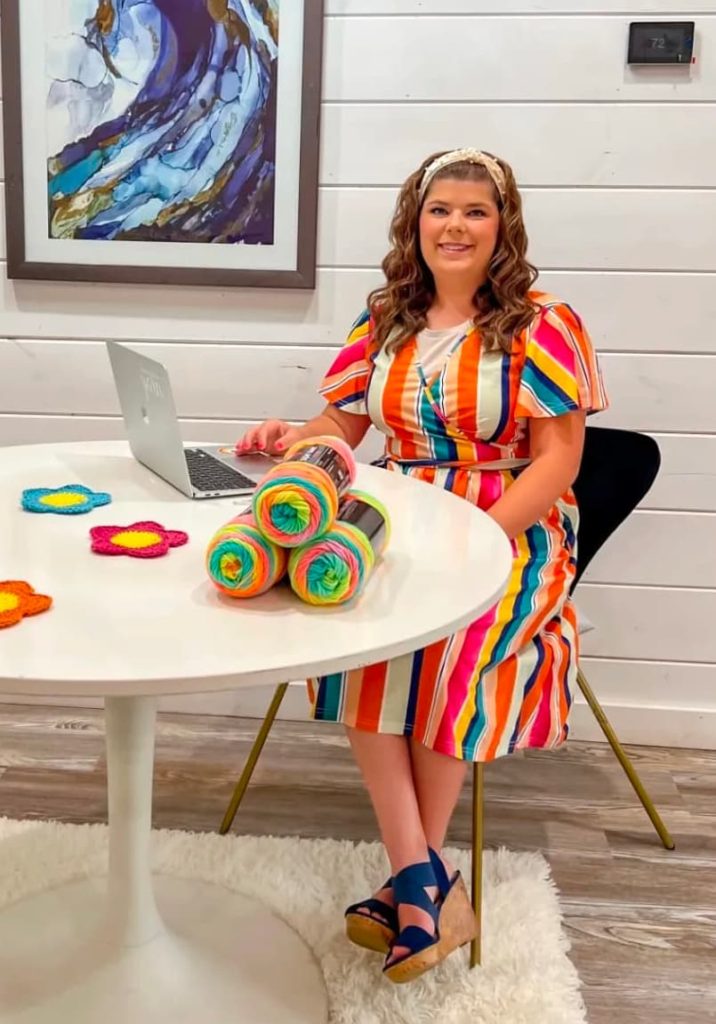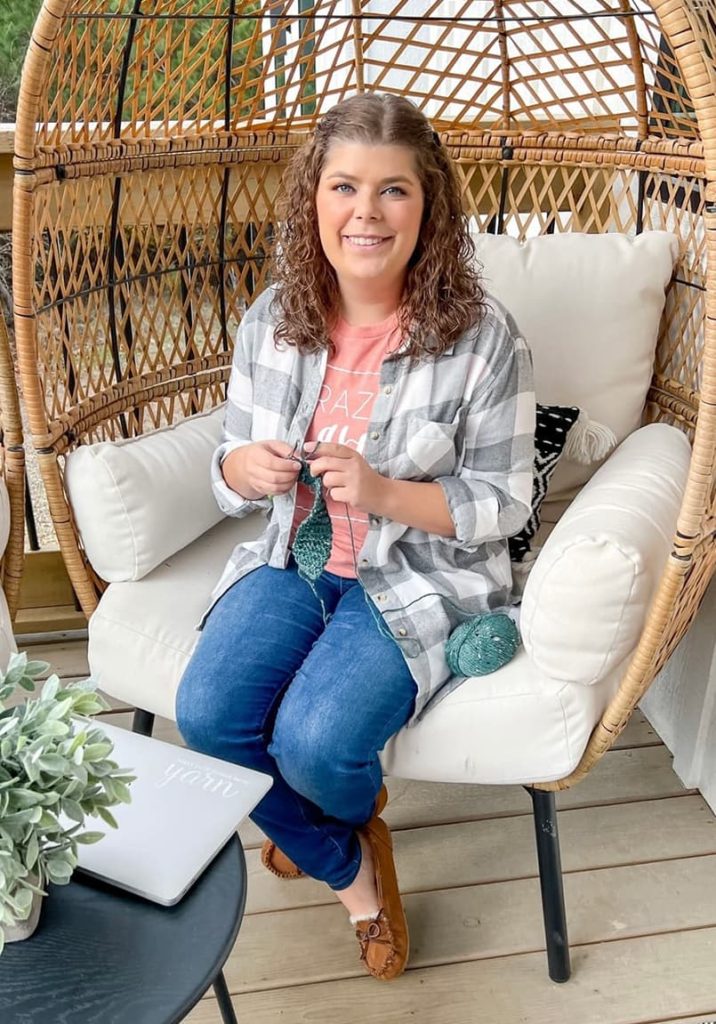This post may contain affiliate links. I may earn a small commission off of at NO extra cost to you. For more info, view my Privacy Policy.
When it comes to picking out the perfect crochet hook, the choices are endless, or at least they seem that way. Not only are there plastic hooks, wooden hooks and metal hooks to choose from, each hook can have a different shape like inline vs tapered crochet hooks.
If you are a little confused and wonder what that means, then this post is for you!
Inline and tapered hooks differ in their design and functionality, and understanding their small differences can help you to choose the best hook to have the best crocheting experience possible.
In this post I will be specifically going over the shape of the crochet hook, inline vs tapered.

If you are wanting to read more about ergonomic crochet hooks and the way they feel and fit into your hand (hello ergonomic handles) then you will want to check out THIS POST.
It’s a helpful post going over different ergonomic hooks (hooks that have different sizes of handles, made out of different materials, etc.) that help if you may suffer from wrist pain or hand fatigue from crocheting for long periods of time.
Inline Crochet Hooks
We will start with inline crochet hooks, also known as Susan Bates-style hooks, feature a consistent shaft diameter from the very tip of the hook all the way down to the grip.
These hooks have a flat throat, which means that the throat and the shaft are in line with each other.
This design aspect makes inline hooks distinctive and sets them apart from tapered hooks with them being easily recognizable. They will look like this –

One pro of using inline crochet hooks (in-line hooks) is their ability to easily slide through stitches. The consistent diameter of the shaft of the hook ensures a smooth glide, which reduces the risk of snagging or splitting the yarn.
Typically, Inline hooks are particularly favored by crocheters who work with tight stitches or prefer faster, uninterrupted stitching.
However, it’s also worth mentioning that inline crochet hooks may require a tiny bit of adjustment in your crochet technique, especially if you are already used to tapered hooks.
Some crocheters find it necessary to change their hand position and grip to accommodate the unique design.
One of the most well known inline crochet hooks would probably have to be Susan Bates Hooks.
Tapered Crochet Hooks
Tapered crochet hooks, often referred to as Boye-style hooks, have a gradually narrowing shaft from the very tip of the hook all the way towards the grip. Unlike inline hooks, tapered hooks have a smooth, rounded throat. They will look like this –

This design feature can often impact the way the yarn flows over and interacts with the hook.
One slight advantage of tapered crochet hooks is their versatility. The tapered shape allows for a better control over stitch size, making them ideal for more intricate patterns or when working with different yarn weights and difficult yarns.
The rounded throat also helps in creating consistent tension and helps to prevent yarn from slipping off the hook by accident. They are a great choice to use if gauge is an important factor for your project.
On the flip side, some crocheters may find that tapered hooks require more effort when inserting the hook into stitches. The tapered shape can sometimes cause the yarn to catch or snag, especially if the tension is too tight.
One of the most popular brands of tapered hooks would probably have to be boye crochet hooks. You can find them at most any craft store and online.
Choosing the Right Hook for Your Project

There are both pros and cons to both type of hook. You may be wondering what is the best hook? Should I choose Inline or Tapered?
The decision between inline and tapered crochet hooks basically all comes down to personal preference and the specific requirements of your project. You may want to consider the following factors when making your choice:
- Stitch Style: If you tend to work with tighter stitches or need to maintain a consistent, even tension, inline hooks may be a better fit. For projects that require intricate stitch work or varying tension, tapered hooks offer more control.
- Yarn Type and Weight: When working with thicker or bulkier yarn, tapered hooks can help navigate through the fibers more easily. For finer yarns, inline hooks can ensure a smooth glide, preventing damage or splitting.
- Hand Comfort: Experiment with both types of hooks to see which design feels more comfortable and ergonomically suitable for your hand and grip. Which one feels natural when actually crocheting with it?
It may also depends on what feels best as to how you grip your hook. I know some people like to use the pencil grip on their hooks while other prefer the knife hold. I’ve always preferred the knife hold myself.
Remember, everyone’s crochet journey is unique and their own, and what works for one person and feels right, may not work for another. Consider trying out different hooks with the same yarn to see which one feels best in your hand and seems more comfortable.
My Personal Favorite Type of Crochet Hooks
Personally, of the 2 different types of crochet hooks, my favorite will always be tapered hooks, hands down. This could be due to the fact that I learned using Boye hooks and it’s what I’m accustomed to and what feels good in my hand. I do use inline hooks on occasion, but they aren’t my go to style of hook as a 1st option.
I’m kinda funny on this because it really depends on the project that I’m working on as to which hook I’ll use. More than not, you can find me using my Clover Amour hooks. They are hands down my favorite crochet hooks ever!

If I’m working on a project where gauge is important such as a hat, sweater or anything that I want to come out to be a specific size, I’ll always use a tapered hook (probably my clovers) because I feel like I always have more control over the sizing of the stitches.
If gauge isn’t important for like a baby blanket or a shawl, then I will consider using an inline hook, such as a Furls Odyssey.
Other than my Furls crochet hooks, all of the crochet hooks I own are tapered in style. I hadn’t realized this until I went to write this post and was looking for an inline hook to compare and I couldn’t find any.
I had to grab my Furls because I keep them separate from all my other hooks, they are kept in a zipper pouch until my collection out grows it.
In the world of crochet there are so many things to learn and try. Finding the perfect hook for yourself can sometimes be a journey, but it will always be worth it once you find it.
So, go try out a bunch of different kinds of hooks. Try aluminum hooks, wood hooks, plastic crochet hooks, clover Amour Crochet hooks, inline hooks or tapered hook.

Give a bunch of different ones a try and see what works best for you!
Happy crocheting!











I like the tapered hook the best. And that’s all I ever use!
I bought the Clover hooks. Love love love them. So much easier to crochet with these. My hand does not tire like the other style. And I don’t fight with the yarn imusing.
I love using both hooks